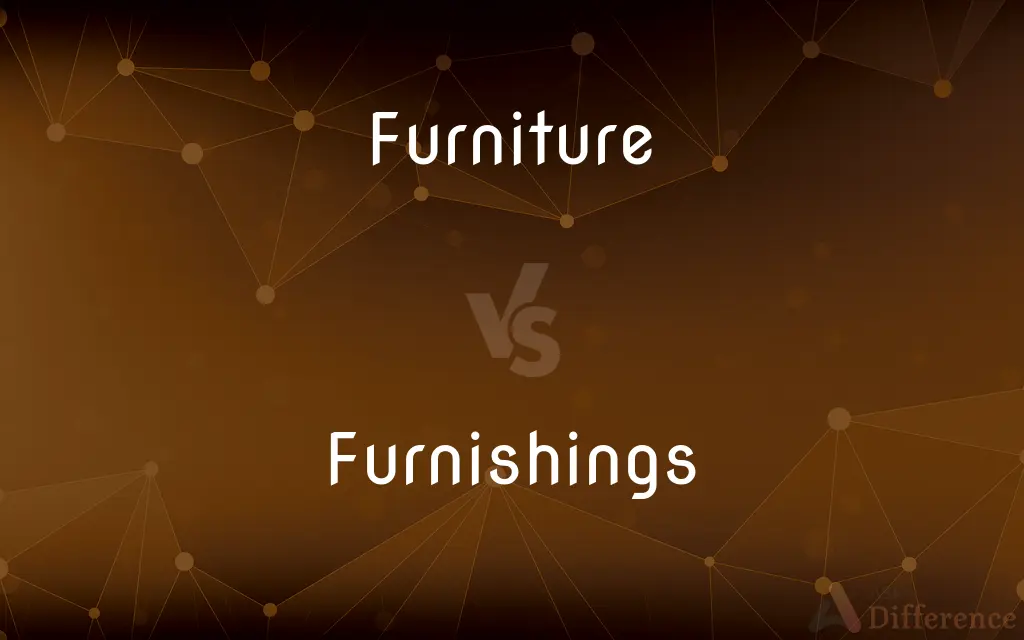Furniture vs. Furnishings — What's the Difference?
By Tayyaba Rehman & Urooj Arif — Updated on May 7, 2024
Furniture refers to large movable items such as tables and chairs used to equip a space, while furnishings include all decorative and functional items that outfit a room, including furniture, curtains, and rugs.

Difference Between Furniture and Furnishings
Table of Contents
ADVERTISEMENT
Key Differences
Furniture typically includes large, durable items such as sofas, beds, tables, and chairs, essential for functional use in living and working spaces. Whereas furnishings encompass a broader category that includes furniture as well as other decorative elements like curtains, rugs, and accessories that contribute to the aesthetics and functionality of a room.
Furniture is central to the practical aspects of a space, providing seating, surfaces, and storage. On the other hand, furnishings play a key role in defining the style, color scheme, and overall ambiance of an environment.
Furniture pieces are usually larger and not changed frequently due to their size and cost. While furnishings can include smaller, more flexible items like cushions, wall art, and lampshades that can be easily swapped out to refresh or update a room’s appearance.
Furniture is necessary for the basic operations of a household or office, such as sitting, sleeping, and eating. Whereas furnishings are used to enhance the comfort, beauty, and utility of a space, often reflecting personal tastes and trends.
Furniture typically requires a significant investment and decision-making focuses on durability and functionality. While furnishings may be selected with more emphasis on color, texture, and design elements, allowing for more frequent updates and personal expression.
ADVERTISEMENT
Comparison Chart
Definition
Large movable items like chairs, tables, and beds
All items including furniture used to decorate and outfit a room
Function
Provides essential functions such as seating and storage
Enhances aesthetic and comfort of a space
Components
Sofas, desks, wardrobes, etc.
Curtains, rugs, cushions, furniture, etc.
Flexibility
Generally less frequently changed
More easily updated or changed
Focus
Durability and utility
Style, design, and personal taste
Compare with Definitions
Furniture
Central to the functionality of homes, offices, and other spaces.
Good furniture is key to a comfortable and efficient office layout.
Furnishings
Often used to express personal style within a space.
Modern furnishings in bold colors can brighten a dull room.
Furniture
Can be a major household investment.
Investing in high-quality furniture can save money in the long run.
Furnishings
Easier to change than furniture, allowing for seasonal or trendy updates.
She updates her home’s furnishings with new cushions and throws each season.
Furniture
Often made from durable materials like wood, metal, or plastic.
The wooden furniture in the room added a warm, natural touch.
Furnishings
Can include textiles like drapes, linens, and upholstery.
Changing the furnishings can quickly update a room’s look.
Furniture
Items typically not included in real estate sales.
The house was sold unfurnished, so the new owners will bring their own furniture.
Furnishings
Includes both functional and decorative items used to complete an interior environment.
The soft furnishings like pillows and curtains made the room feel cozy.
Furniture
Large movable items designed to support various human activities like seating, eating, and sleeping.
She bought a new bed and dining table to replace the old furniture.
Furnishings
Accessories such as lamps, art, and decorative objects are also considered furnishings.
She added new lamps and wall art to refresh the room’s furnishings.
Furniture
Furniture refers to movable objects intended to support various human activities such as seating (e.g., chairs, stools, and sofas), eating (tables), and sleeping (e.g., beds). Furniture is also used to hold objects at a convenient height for work (as horizontal surfaces above the ground, such as tables and desks), or to store things (e.g., cupboards and shelves).
Furnishings
A piece of equipment necessary or useful for comfort or convenience.
Furniture
The movable articles in a room or an establishment that make it fit for living or working.
Furnishings
Furnishings The furniture, appliances, and other movable articles in a home or other building.
Furniture
(Archaic) Necessary equipment, as for a saddle horse or sailing ship.
Furnishings
Furnishings Wearing apparel and accessories.
Furniture
Large movable item(s), usually in a room, which enhance(s) the room's characteristics, functionally or decoratively.
The woman does not even have one stick of furniture moved in yet.
How much furniture did they leave behind?
A chair is furniture. Sofas are also furniture.
They bought a couple of pieces of furniture.
Your furniture is beautiful.
Furnishings
Plural of furnishing
Furniture
The harness, trappings etc. of a horse, hawk, or other animal.
Furnishings
Furniture generally.
Furniture
Fittings, such as handles, of a door, coffin, or other wooden item.
Furnishings
The objects, other than furniture, that occupy an interior space.
Furniture
(obsolete) An accompanying enhancing feature, or features collectively; embellishment, decoration, trimming.
Furnishings
Accessories used with a dress.
Furniture
(firearms) The stock and forearm of a weapon.
Furnishings
Items of furniture and/or accessories by which something is equipped so as to be more useful, convenient, or comfortable.
Furniture
The pieces of wood or metal put round pages of type to make proper margins and fill the spaces between the pages and the chase.
Furnishings
The furniture and appliances and other movable accessories (including curtains and rugs) that make a home (or other building) livable.
Furniture
(journalism) Any material on the page other than the body text and pictures of articles; for example, headlines, datelines and dinkuses, lines and symbols (though in earlier use, only non-text elements of page design, such as lines and symbols).
Furnishings
Accessory wearing apparel.
Furniture
(music) A type of mixture organ stop.
Furnishings
The instrumentalities (furniture and appliances and other movable accessories including curtains and rugs) that make a home (or other area) livable
Furniture
(archaic) Draped coverings and hangings; bedsheets, tablecloths, tapestries, etc.
Furnishings
Accessory wearing apparel
Furniture
(obsolete) Clothing with which a person is furnished; apparel, outfit.
Furniture
(obsolete) Arms and armor, equipment of war.
Furniture
(archaic) Equipment for work, apparatus, tools, instruments.
Furniture
Condiments of a salad.
Furniture
(obsolete) Stock, supply, stores, provisions.
Furniture
(obsolete) Contents; that with which something is filled or stocked.
Furniture
(bookselling) Impressive-looking books used for filling out the collection of a private library.
Furniture
(obsolete) The action of furnishing or supplying.
Furniture
(obsolete) The condition of being equipped, prepared, or mentally cultivated.
Furniture
That with which anything is furnished or supplied; supplies; outfit; equipment.
The form and all the furniture of the earth.
The thoughts which make the furniture of their minds.
Furniture
Articles used for convenience or decoration in a house or apartment, as tables, chairs, bedsteads, sofas, carpets, curtains, pictures, vases, etc.
Furniture
The necessary appendages to anything, as to a machine, a carriage, a ship, etc.
Furniture
A mixed or compound stop in an organ; - sometimes called mixture.
Furniture
Furnishings that make a room or other area ready for occupancy;
They had too much furniture for the small apartment
There was only one piece of furniture in the room
Common Curiosities
What is the main purpose of furniture?
To provide necessary functions like seating, sleeping, and storage in living spaces.
Do you need to match furniture and furnishings?
While not necessary, coordinating furniture and furnishings can enhance room cohesion.
How often should furnishings be replaced?
Furnishings can be replaced as often as needed to update a room’s style or function.
How do furnishings contribute to a room?
Furnishings contribute to both the aesthetic appeal and comfort of a room.
Can furnishings include electrical fixtures?
Yes, furnishings can include light fixtures and other decorative electrical items.
How can changing furnishings impact a home’s atmosphere?
Updating furnishings can significantly alter the mood and style of a home.
Are furnishings considered a good investment?
While not typically appreciating in value, quality furnishings can improve living quality and satisfaction.
What types of materials are common in furnishings?
Common materials include textiles, wood, metal, and synthetic fibers.
What should be considered when selecting furniture?
Consider durability, functionality, size, and how well it fits with the intended space.
Is it cheaper to buy furniture or furnishings?
Generally, furnishings can be less expensive than furniture, especially larger pieces.
Share Your Discovery

Previous Comparison
Pneumonia vs. Emphysema
Next Comparison
Transcription vs. TranscribeAuthor Spotlight
Written by
Tayyaba RehmanTayyaba Rehman is a distinguished writer, currently serving as a primary contributor to askdifference.com. As a researcher in semantics and etymology, Tayyaba's passion for the complexity of languages and their distinctions has found a perfect home on the platform. Tayyaba delves into the intricacies of language, distinguishing between commonly confused words and phrases, thereby providing clarity for readers worldwide.
Co-written by
Urooj ArifUrooj is a skilled content writer at Ask Difference, known for her exceptional ability to simplify complex topics into engaging and informative content. With a passion for research and a flair for clear, concise writing, she consistently delivers articles that resonate with our diverse audience.
















































